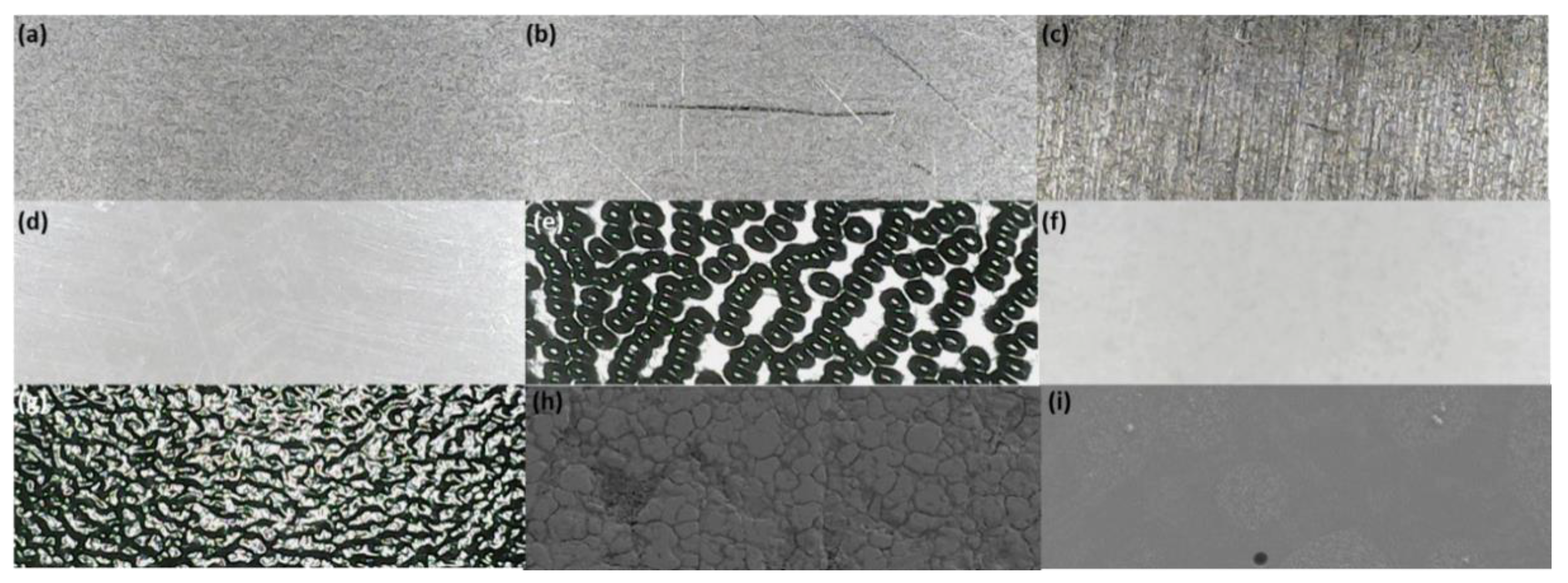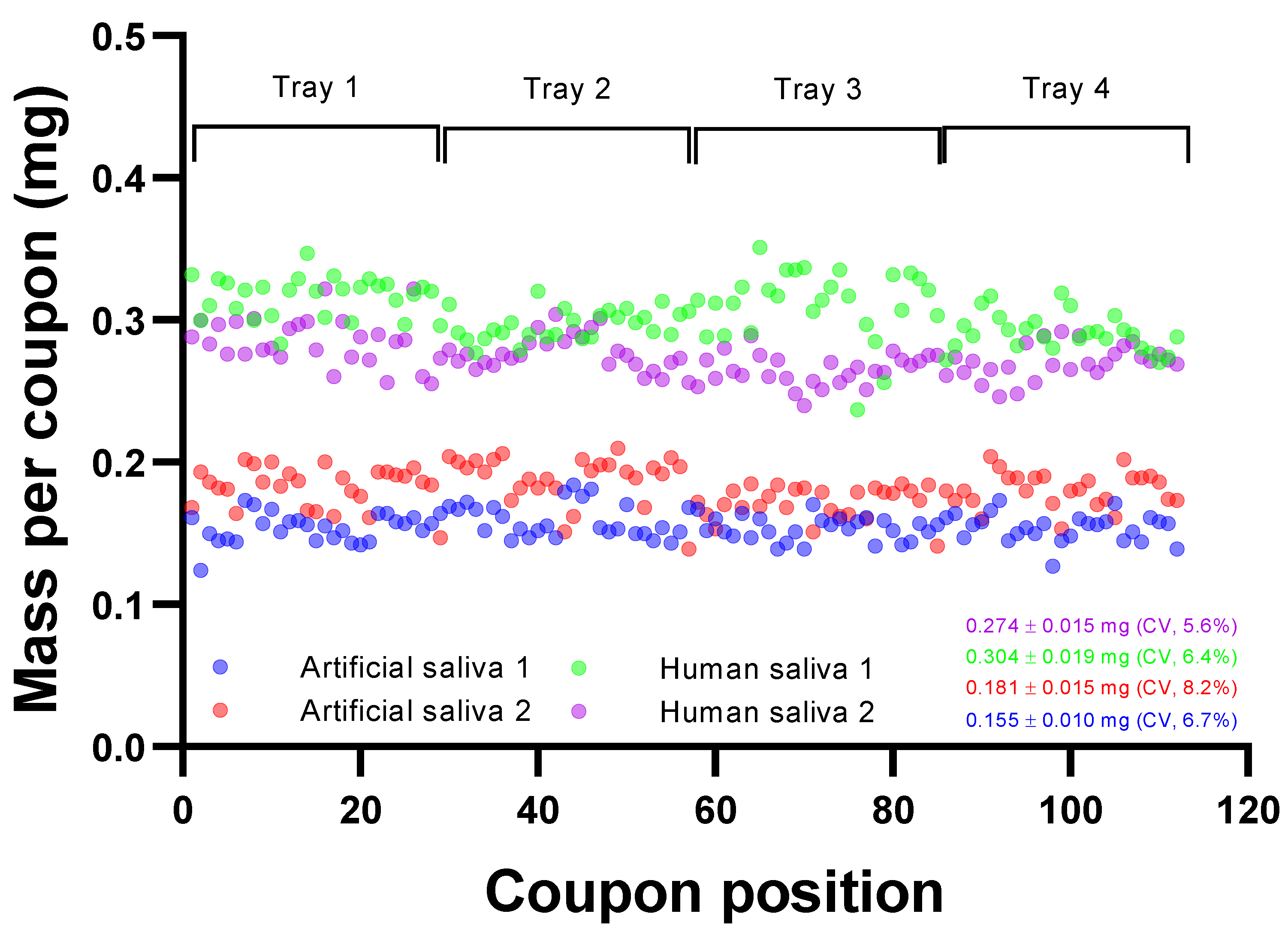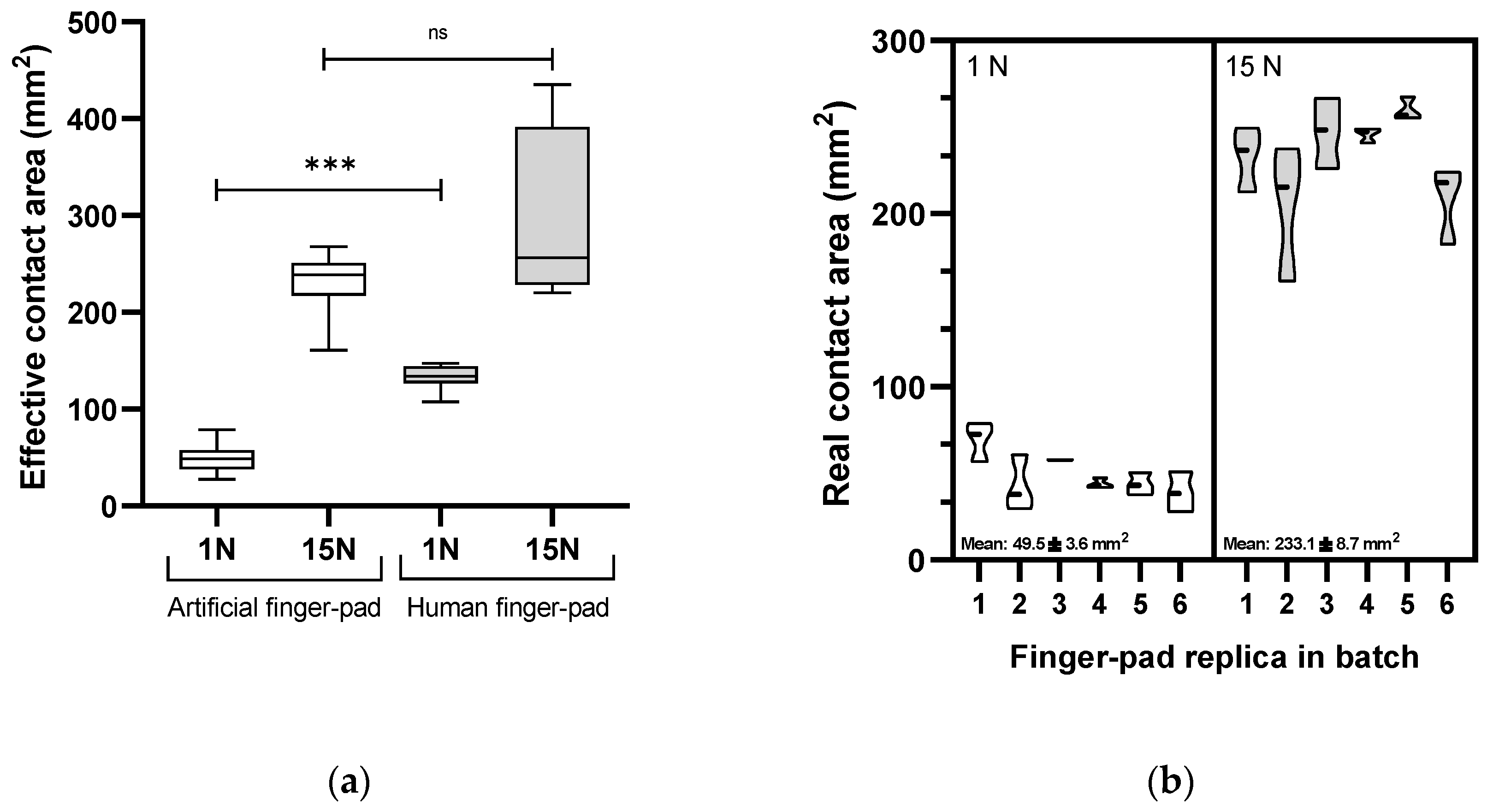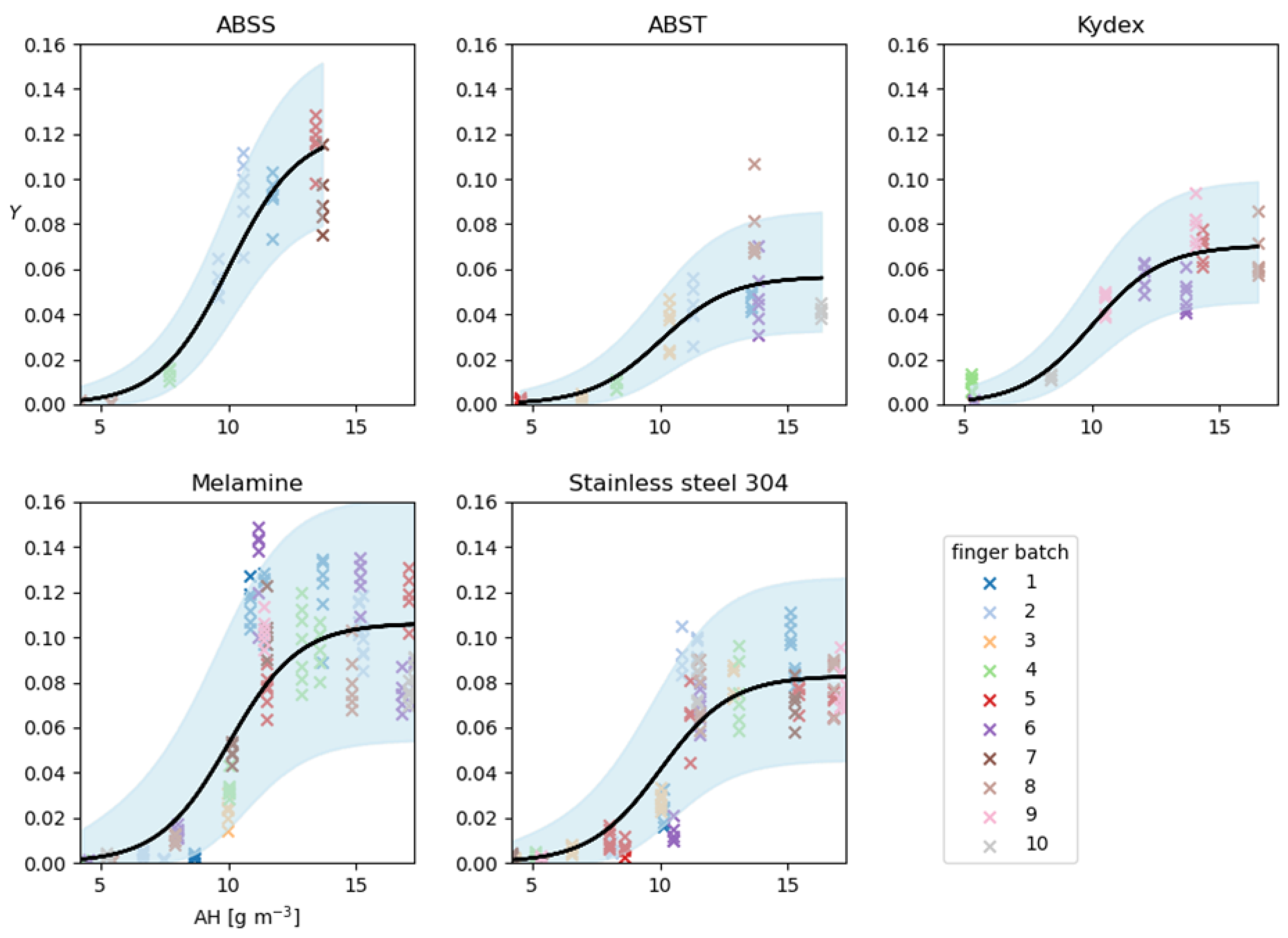Effect of Relative Humidity on Transfer of Aerosol-Deposited Artificial and Human Saliva from Surfaces to Artificial Finger-Pads
Abstract
:1. Introduction
2. Materials and Methods
2.1. Coupon Materials
2.2. Aerosol Deposition onto Coupons
2.3. Production and Characterization of Artificial Finger-Pads
2.4. Measurement of Surface Energy and Dynamic Contact Angles
2.5. Determination of Transfer Efficiency from Coupon to Artificial Finger-Pad
2.6. Quantitative Microbial Risk Assessment (QMRA) Modeling
2.6.1. Development of Linear Regression Model of Transfer Efficiency Data
2.6.2. Analysis of Effect of Environmental Factors on Risk of Fomite Transmission
2.7. Statistical Analysis
3. Results
3.1. Development of a Standardized Experimental Process for Aerosol Deposition onto and Recovery from Surfaces
3.1.1. Characterization of Coupon Surfaces
3.1.2. Aerosol Deposition
3.2. Development of Artificial Finger-Pad with Characteristics of Human Finger Touch
3.2.1. Topological Detail and Effective Contact Area
3.2.2. Influence of Sweat and Sebum Finger-Pad Wettability on Transfer
3.3. Transfer of Artificial and Human Saliva from Surfaces to Artificial Finger-Pads
3.3.1. Relative Humidity and Surface Complexity Influence Transfer of Artificial and Human Saliva
3.3.2. Development of a Regression Model for Humidity and Impact in QMRA Model
4. Discussion
5. Conclusions
- Transfer efficiency increases with increasing humidity for all materials studied. At RH <40%, transfer from all surfaces was <10%, and increased markedly as RH increased, reaching a maximum of approximately 50%.
- The quantity of material transferred at specific RHs above 40% was dependent on the roughness of the surface material and the properties of the aerosol-deposited material. Smooth surfaces, such as melamine and stainless steel, generated higher transfer efficiencies compared to those with textured roughness, such as ABS pinseal and KYDEX® plastics.
- Pooled human saliva was transferred at a lower rate compared to artificial saliva, indicating the role of rheological properties.
- QMRA analysis using SARS-CoV-2 suggests that the highest risks of fomite transmission are likely in indoor environments with normal temperatures (around 22 °C) and higher humidity (>65% RH). This suggests humid spaces could pose a higher risk.
Supplementary Materials
Author Contributions
Funding
Institutional Review Board Statement
Informed Consent Statement
Data Availability Statement
Acknowledgments
Conflicts of Interest
References
- Gwaltney, J.M.; Moskalski, P.B.; Hendley, J.O. Hand-to-hand transmission of rhinovirus colds. Ann. Int. Med. 1978, 88, 463–467. [Google Scholar] [CrossRef] [PubMed]
- Boone, S.A.; Gerba, C.P. Significance of fomites in the spread of respiratory and enteric viral disease. Appl. Environ. Microbiol. 2007, 73, 1687–1696. [Google Scholar] [CrossRef] [PubMed] [Green Version]
- Lopez, G.U.; Gerba, C.P.; Tamimi, A.H.; Kitajima, M.; Maxwell, S.L.; Rose, J.B. Transfer efficiency of bacteria and viruses from porous and nonporous fomites to fingers under different relative humidity conditions. Appl. Environ. Microbiol. 2013, 79, 5728–5734. [Google Scholar] [CrossRef] [PubMed] [Green Version]
- Stephens, B.; Parham, A.; Thoemmes, M.S.; Heidarinejad, M.; Allen, J.G.; Gilbert, J.A. Microbial exchange via fomites and implications for human health. Curr. Pollut. Rep. 2019, 5, 198–213. [Google Scholar] [CrossRef] [Green Version]
- Derler, S.; Gerhardt, L.C. Tribology of skin: Review and analysis of experimental results for the friction coefficient of human skin. Tribol. Lett. 2012, 45, 1–27. [Google Scholar] [CrossRef] [Green Version]
- Cornuault, P.H.; Carpentier, L.; Bueno, M.-A.; Cote, J.-M.; Monteil, G. Influence of physico-chemical, mechanical and morphological fingerpad properties on the frictional distinction of sticky/slippery surfaces. J. R. Soc. Interface 2015, 12. [Google Scholar] [CrossRef]
- Van Kuilenburg, J.; Masen, M.A.; van der Heide, E. A review of fingerpad contact mechanics and friction and how this affects tactile perception. J. Eng. Tribol. 2015, 229, 243–258. [Google Scholar] [CrossRef]
- Zhao, P.; Li, Y. Modeling and experimental validation of microbial transfer via surface touch. Environ. Sci. Technol. 2021, 55, 4148–4161. [Google Scholar] [CrossRef]
- Todt, D.; Meister, T.L.; Tamele, B.; Howes, J.; Paulmann, D.; Becker, B.; Brill, F.H.; Wind, M.; Schijven, J.; Heinen, N.; et al. A realistic transfer method reveals low risk of SARS-CoV-2 transmission via contaminated euro coins and banknotes. iScience 2021, 24, 102908. [Google Scholar] [CrossRef]
- Behzadinasab, S.; Chin, A.W.H.; Hosseini, M.; Poon, L.L.M.; Ducker, W.A. SARS-CoV-2 virus transfers to skin through contact with contaminated solids. Sci. Rep. 2021, 11, 22868. [Google Scholar] [CrossRef]
- Butot, S.; Zuber, S.; Moser, M.; Baert, L. Data on transfer of human coronavirus SARS-CoV-2 from foods and packaging materials to gloves indicate that fomite transmission is of minor importance. Appl. Environ. Microbiol. 2022, 8, e02338-21. [Google Scholar] [CrossRef] [PubMed]
- Julian, T.R.; Leckie, J.O.; Boehm, A.B. Virus transfer between fingerpads and fomites. J. Appl. Microbiol. 2010, 109, 1868–1874. [Google Scholar] [CrossRef] [PubMed]
- Kwok, Y.L.A.; Gralton, J.; McLaws, M.-L. Face touching: A frequent habit that has implications for hand hygiene. Am. J. Infect. Cont. 2015, 43, 112–114. [Google Scholar] [CrossRef] [PubMed]
- King, M.-F.; López-García, M.; Atedoghu, K.P.; Zhang, N.; Wilson, A.M.; Weterings, M.; Hiwar, W.; Dancer, S.J.; Noakes, C.J.; Fletcher, L.A. Bacterial transfer to fingertips during sequential surface contacts with and without gloves. Indoor Air 2020, 30, 993–1004. [Google Scholar] [CrossRef] [PubMed]
- Jinadatha, C.; Villamaria, F.C.; Coppin, J.D.; Dale, C.R.; Williams, M.D.; Whitworth, R.; Stibich, M. Interaction of healthcare worker hands and portable medical equipment: A sequence analysis to show potential transmission opportunities. BMC Infect. Dis. 2017, 17, 800. [Google Scholar] [CrossRef] [PubMed] [Green Version]
- Wilson, A.M.; Verhougstraete, M.P.; Beamer, P.I.; King, M.-F.; Reynolds, K.A.; Gerba, C.P. Frequency of hand-to-head, -mouth, -eyes, and –nose contacts for adults and children during eating and non-eating macro-activities. J. Exp. Sci. Environ. Epidemiol. 2021, 31, 34–44. [Google Scholar] [CrossRef] [PubMed]
- Anderson, C.E.; Boehm, A.B. Transfer rate of enveloped and non-enveloped viruses between fingerpads and surfaces. Appl. Environ. Microbiol. 2021, 87, e0121521. [Google Scholar] [CrossRef]
- Biryukov, J.; Boydston, J.A.; Dunning, R.A.; Yaeger, J.J.; Wood, S.; Reese, A.L.; Ferris, A.; Miller, D.; Weaver, W.; Zeitouni, N.E.; et al. Increasing temperature and relative humidity accelerates inactivation of SARS-CoV-2 on surfaces. mSphere 2020, 5, e00441-20. [Google Scholar] [CrossRef]
- Hirose, R.; Ikegaya, H.; Naito, Y.; Watanabe, N.; Yoshida, T.; Bandou, R.; Daidoji, T.; Itoh, Y.; Nakaya, T. Survival of SARS-CoV-2 and influenza virus on the human skin: Importance of hand hygiene in COVID-19. Clin. Infect. Dis. 2021, 73, e4329–e4335. [Google Scholar] [CrossRef]
- Ratnesar-Shumate, S.; Williams, G.; Green, B.; Krause, M.; Holland, B.; Wood, S.; Bohannon, J.; Boydston, J.; Freeburger, D.; Hooper, I.; et al. Simulated sunlight rapidly inactivates SARS-CoV-2 on surfaces. J. Infect. Dis. 2020, 2, 214–222. [Google Scholar] [CrossRef]
- Ronca, S.E.; Sturdivant, R.X.; Barr, K.L.; Harris, D. SARS-CoV-2 viability on 16 common indoor surface finish materials. HERD 2021, 14, 49–64. [Google Scholar] [CrossRef] [PubMed]
- Pöhlker, M.L.; Krüger, O.O.; Förster, J.-D.; Berkemeier, T.; Elbert, W.; Fröhlich-Nowoisky, J.; Pöschl, U.; Pöhlker, C.; Bagheri, G.; Bodenschatz, E.; et al. Respiratory aerosols and droplets in the transmission of infectious diseases. arXiv 2021, arXiv:2103.01188. [Google Scholar]
- Wang, C.T.; Fu, S.C.; Chao, C.Y.H. Short-range bioaerosol deposition and recovery of viable viruses and bacteria on surfaces from a cough and implications for respiratory disease transmission. Aerosol Sci. Technol. 2021, 55, 215–230. [Google Scholar] [CrossRef]
- Haas, C.; Rose, J.; Gerba, C. Quantitative Microbial Risk Assessment, 2nd ed.; John Wiley & Sons, Inc.: Hoboken, NJ, USA, 2014. [Google Scholar]
- Woo, M.-H.; Hsu, Y.-M.; Wu, C.-Y.; Heimbuch, B.; Wander, J. Method for contamination of filtering facepiece respirators by deposition of MS2 viral aerosols. J. Aerosol Sci. 2010, 41, 944–952. [Google Scholar] [CrossRef] [PubMed]
- Khan, G.J.; Mahmood, R.; Ihtesham-ul-Haq; Salah-ud-Din. Secretion of total solids (solutes) in the saliva of long-term tobacco users. J. Ayub Med. Coll. Abbotabad 2008, 20, 20–22. [Google Scholar]
- Liu, X.; Carre, M.J.; Zhang, Q.; Lu, Z.; Matcher, S.J.; Lewis, R. Measuring contact area in a sliding human finger-pad contact. Skin Res. Technol. 2018, 24, 31–44. [Google Scholar] [CrossRef]
- Morris, D.; Yinda, K.C.; Gamble, A.; Rossine, F.W.; Huang, Q.; Bushmaker, T.; Fischer, R.J.; Matson, M.J.; van Doremalen, N.; Vikeslund, P.J.; et al. Mechanistic theory predicts the effects of temperature and humidity on inactivation of SARS-CoV-2 and other enveloped viruses. eLife 2021, 10, e65902. [Google Scholar] [CrossRef]
- Chen, H.; Tang, T.; Amirfazli, A. Liquid transfer mechanism between two surfaces and the role of contact angles. Soft Matter 2014, 15, 2503–2507. [Google Scholar] [CrossRef]
- Adams, M.J.; Johnson, S.A.; Lefèvre, P.; Lévesque, V.; Hayward, V.; André, T.; Thonnard, J.-L. Finger pad friction and its role in grip and touch. J. R. Soc. Interface 2013, 10, 20120467. [Google Scholar] [CrossRef] [Green Version]
- Khyat, A.E.; Mavon, A.; Leduc, M.; Agache, P.; Humbert, P. Skin critical surface tension—A way to assess the skin wettability quantitatively. Skin Res. Technol. 1996, 2, 91–96. [Google Scholar] [CrossRef]
- Al Zubaidy, E.A.H.; Mohammad, F.S.; Bassionia, G. Effect of pH, salinity and temperature on aluminum cookware leaching during food preparation. Int. J. Electrochem. Sci. 2011, 6, 6424–6441. [Google Scholar]
- Bara, M.; Niedzwiedz, M.; Skoneczny, W. Influence of anodizing parameters on surface morphology and surface-free energy of Al2O3 layers produced on EN AW-5251 alloy. Materials 2019, 12, 695. [Google Scholar] [CrossRef] [PubMed] [Green Version]
- Xie, X.; Li, Y.; Sun, H.; Liu, L. Exhaled droplets due to talking and coughing. J. R. Soc. Interface 2009, 6, S703–S714. [Google Scholar] [CrossRef] [Green Version]
- Oprişan, C.; Carlescu, V.; Barnea, A.; Prisacaru, G.; Olaru, D.N.; Plesu, G. Experimental determination of the Young’s modulus for the fingers with application in prehension systems for small cylindrical objects. IOP Conf. Ser. Mater. Sci. Eng. 2016, 147, 012058. [Google Scholar] [CrossRef] [Green Version]
- Wang, Q.; Hayward, V. In vivo biomechanics of the fingerpad skin under local tangential traction. J. Biomechan. 2007, 40, 851–860. [Google Scholar] [CrossRef] [PubMed] [Green Version]
- Ahmadzadeh, S.M.H.; Hukins, D.W.L. Feasibility of using mixtures of silicone elastomers and silicone oils to model the mechanical behaviour of biological tissues. Proc. Inst. Mech. Eng. H 2014, 228, 730–734. [Google Scholar] [CrossRef] [PubMed] [Green Version]
- Walker, J.S.; Archer, J.; Gregson, F.K.A.; Michel, S.E.S.; Bzdek, B.R.; Reid, J.P. Accurate representations of the microphysical processes occurring during the transport of exhaled aerosols and droplets. ACS Cent. Sci. 2021, 7, 200–209. [Google Scholar] [CrossRef]
- Anand, P.; Bannerjee, R. Comparison of artificial saliva substitutes. Trends Biomater. Artif. Org. 2005, 18, 178–186. [Google Scholar]
- Pytko-Polonczyk, J.J.; Jakubik, A.; Przeklasa-Bierowiec, A.B.; Muszynska, B. Artificial saliva and its use in biological experiments. J. Physiol. Pharmacol. 2017, 68, 807–813. [Google Scholar]
- Ngamchuea, K.; Chaisiwamongkhol, K.; Batchelor-McAuley, C.; Compton, R.G. Chemical analysis in saliva and the search for salivary biomarkers—A tutorial review. Analyst 2018, 143, 81–99. [Google Scholar] [CrossRef]
- Frenkel, E.S.; Ribbeck, K. Salivary mucins in host defense and disease presentation. J. Oral Microbiol. 2015, 7, 29759. [Google Scholar] [CrossRef] [PubMed]
- Corfield, A.P. Mucins: A biologically relevant glycan barrier in mucosal protection. Biochim. Biophys. Acta Gen. Subj. 2015, 1850, 236–252. [Google Scholar] [CrossRef] [PubMed]
- Ryan, B.J.; Poduska, K.M. Roughness effects on contact angle measurements. Am. J. Phys. 2008, 298, 1107–1112. [Google Scholar] [CrossRef] [Green Version]
- Wang, J.; Wu, Y.; Cao, Y.; Li, G.; Liao, Y. Influence of surface roughness on contact angle hysteresis and spreading work. Coll. Polym. Sci. 2020, 298, 1107–1112. [Google Scholar] [CrossRef]
- Gerba, C.P.; Leija, B.M.; Ikner, L.A.; Gundy, P.; Rutala, W.A. Transfer efficiency of an enveloped virus, human coronavirus 229E, from various hard surface fomites to finger pads of the hands. Infect. Cont. Hosp. Epidemiol. 2021, 1–3. [Google Scholar] [CrossRef]
- Dallner, M.; Harlow, J.; Nasheri, N. Human coronaviruses do not transfer efficiently between surfaces in the absence of organic materials. Viruses 2021, 13, 135. [Google Scholar] [CrossRef]
- Fedorenko, A.; Grinberg, M.; Orevi, T.; Kashtan, N. Survival of the enveloped bacteriophage phi6 (a surrogate for SARS-CoV-2) in evaporated saliva microdroplets deposited on glass surfaces. Sci. Rep. 2020, 10, 22419. [Google Scholar] [CrossRef]
- Huang, Q.; Wang, W.; Vikesland, P.J. Implications of the coffee-ring effect on virus infectivity. Langmuir 2021, 37, 11260–11268. [Google Scholar] [CrossRef]
- Rasheed, A.; Sharma, S.; Kabi, P.; Saha, A.; Chaudhuri, S.; Basu, S. Precipitation dynamics of surrogate respiratory sessile droplets leading to possible fomites. J. Coll. Interface Sci. 2021, 600, 1–13. [Google Scholar] [CrossRef]
- Vejerano, E.P.; Marr, L.C. Physico-chemical characteristics of evaporating respiratory fluid droplet. J. R. Soc. Interface 2018, 15, 20170939. [Google Scholar] [CrossRef] [Green Version]
- Yildirim, O.E.; Basaran, O.A. Deformation and breakup of stretching bridges of Newtonian and shear-thinning liquids: Comparison of one- and two-dimensional models. Chem. Engin. Sci. 2001, 56, 211–233. [Google Scholar] [CrossRef]
- Brajkovic, D.; Ducharme, M.B.; Frim, J. Relationship between body heat content and finger temperature during cold exposure. J. Appl. Physiol. 2001, 90, 2445–2452. [Google Scholar] [CrossRef] [PubMed]
- Pasumarty, S.M.; Johnson, S.A.; Watson, S.A.; Adams, M.J. Friction of the human finger pad: Influence of moisture, occlusion and velocity. Tribol. Lett. 2011, 44, 117. [Google Scholar] [CrossRef]
- Dancer, S.J.; Li, Y.; Hart, A.; Tang, J.W.; Jones, D.L. What is the risk of acquiring SARS-CoV-2 from the use of public toilets? Sci. Total Environ. 2021, 792, 148341. [Google Scholar] [CrossRef]
- Lin, K.; Marr, L.C. Humidity-dependent decay of viruses, but not bacteria, in aerosols and droplets follows disinfection kinetics. Environ. Sci. Technol. 2020, 54, 1024–1032. [Google Scholar] [CrossRef]
- Ansari, S.A.; Springthorpe, V.S.; Sattar, S.A.; Rivard, S.; Rahman, M. Potential role of hands in the spread of respiratory viral infections: Studies with human parainfluenza virus 3 and rhinovirus 14. J. Clin. Microbiol. 1991, 29, 2115–2119. [Google Scholar] [CrossRef] [Green Version]
- Mbithi, J.N.; Springthorpe, V.S.; Boulet, J.R.; Sattar, S.A. Survival of hepatitis A virus on human hands and its transfer on contact with animate and inanimate surfaces. J. Clin. Microbiol. 1992, 30, 757–763. [Google Scholar] [CrossRef] [Green Version]
- Bidawad, S.; Farber, J.M.; Sattar, S.A. Contamination of foods by food handlers: Experiments on hepatitis A virus transfer to food and its interruption. Appl. Environ. Microbiol. 2004, 66, 2759–2763. [Google Scholar] [CrossRef] [Green Version]
- Tuladhar, E.; Hazeleger, W.C.; Koopmans, M.; Zweitering, M.H.; Duizer, E.; Beumer, R.R. Transfer of noroviruses between fingers and fomites and food products. Int. J. Food Microbiol. 2013, 167, 346–352. [Google Scholar] [CrossRef]
- Stals, A.; Uyttendaele, M.; Baert, L.; van Coillie, E. Norovirus transfer between foods and food contact materials. J. Food Protect. 2013, 76, 1202–1209. [Google Scholar] [CrossRef] [Green Version]
- Greene, C.; Vadlamudi, G.; Eisenberg, M.; Foxman, B.; Koopman, J.; Xi, C. Fomite-fingerpad transfer efficiency (pick-up and deposit) of Acinetobacter baumannii with and without a latex glove. Am. J. Infect. Cont. 2015, 43, 928–934. [Google Scholar] [CrossRef] [PubMed]
- Koenig, D.W.; Korir-Morrison, C.; Hoffman, D.R. Transfer efficiency of Staphylococcus aureus between nitrile exam gloves and nonporous fomites. Am. J. Infect. Cont. 2016, 44, 245–246. [Google Scholar] [CrossRef] [PubMed]
- Vilčeková, S.; Apostoloski, I.Z.; Mečiarová, L.; Burdová, E.K.; Kiseľák, J. Investigation of indoor air quality in houses of Macedonia. Int. J. Environ. Res. Public Health 2017, 14, 37. [Google Scholar] [CrossRef] [Green Version]
- Nguyen & Dockery Daily indoor-to-outdoor temperature and humidity relationships: A sample across seasons and diverse climatic regions. Int. J. Biometeorol. 2016, 60, 221–229.
- Pullinger, M.; Goddard, N.; Berliner, N.; Webb, L.; Dzikovska, M.; Lovell, H.; Mann, J.; Sutton, C.; Webb, J.; Zhong, M. The IDEAL household energy dataset, electricity, gas, contextual sensor data and survey data for 255 UK homes. Sci. Data 2021, 8, 146. [Google Scholar] [CrossRef]
- Stan Development Team. Stan Modeling Language Users Guide and Reference Manual, 2022, 2.28. Available online: https://mc-stan.org (accessed on 1 March 2022).
- Hoffman, M.; Gelman, A. The No-U-turn sampler: Adaptively setting path lengths in Hamiltonian Monte Carlo. J. Mach. Learn. Res. 2016, 15, 1593–1623. [Google Scholar]
- Gelman, A.; Carlin, J.B.; Stern, H.S.; Dunson, D.B.; Vehtari, A.; Rubin, D.B. Bayesian Data Analysis, 3rd ed.; Chapman and Hall: London, UK; CRC: Boca Raton, FL, USA, 2013. [Google Scholar] [CrossRef]








| Coupon Surface | Example High-Touch Surfaces Represented | Roughness Profile Parameters 1 | Surface Energy (mN·m−1) 2 | Contact Angles 3 | |||
|---|---|---|---|---|---|---|---|
| Ra | Rq | Rz | θAdv; θRec | Δθr | |||
| SS304 | Door handles, hand poles, keypads, taps, cutlery | 0.167 ± 0.024 | 0.250 ± 0.046 | 4.05 ± 0.73 | 26.3 ± 0.26 | 80.6; 44.3 | 14.2 |
| ALU | Door push plates, handrails, furniture handles | 0.454 ± 0.037 | 0.639 ± 0.048 | 6.94 ± 1.34 | 25.8 ± 0.36 | 92.7; 35.3 | 23.2 |
| MEL | Table surfaces, kitchen cabinets, decorative panels | 0.419 ± 0.024 | 0.524 ± 0.038 | 3.57 ± 0.71 | 29.2 ± 0.52 | 93.9; 38.2 | 20.3 |
| ABSS 4 | Entry/exit press, keypads, sockets, housing, dashboard | 0.127 ± 0.014 | 0.174 ± 0.017 | 1.73 ± 0.097 | 28.9 ± 0.23 | 72.2; 47.4 | 11.1 |
| ABST 4 | Entry/exit press, keypads, sockets, housing, dashboard | 33.11 ± 0.67 | 38.87 ± 0.78 | 165.7 ± 10.8 | 33.7 ± 0.43 | 73.8; 32.1 | 26.4 |
| KYD 4 | Trays, storage lockers, hand rests, seat backs, holsters | 4.49 ± 0.186 | 5.53 ± 0.245 | 30.3 ± 1.81 | 28.3 ± 0.32 | 82.5; 43.5 | 15.0 |
| Silicone 5 | No sweat–sebum Sweat–sebum | ND | ND | ND | 26.7 ± 0.37 ND | 82.6; 68.4 68.9; 58.5 | ND |
| Art. silicone finger-pad | No sweat–sebum Sweat–sebum | ND | ND | ND | 28.2 ± 0.34 56.2 ± 0.72 | ND | |
Publisher’s Note: MDPI stays neutral with regard to jurisdictional claims in published maps and institutional affiliations. |
© 2022 by the authors. Licensee MDPI, Basel, Switzerland. This article is an open access article distributed under the terms and conditions of the Creative Commons Attribution (CC BY) license (https://creativecommons.org/licenses/by/4.0/).
Share and Cite
Walker, M.D.; Vincent, J.C.; Benson, L.; Stone, C.A.; Harris, G.; Ambler, R.E.; Watts, P.; Slatter, T.; López-García, M.; King, M.-F.; et al. Effect of Relative Humidity on Transfer of Aerosol-Deposited Artificial and Human Saliva from Surfaces to Artificial Finger-Pads. Viruses 2022, 14, 1048. https://doi.org/10.3390/v14051048
Walker MD, Vincent JC, Benson L, Stone CA, Harris G, Ambler RE, Watts P, Slatter T, López-García M, King M-F, et al. Effect of Relative Humidity on Transfer of Aerosol-Deposited Artificial and Human Saliva from Surfaces to Artificial Finger-Pads. Viruses. 2022; 14(5):1048. https://doi.org/10.3390/v14051048
Chicago/Turabian StyleWalker, Maurice D., Jack C. Vincent, Lee Benson, Corinne A. Stone, Guy Harris, Rachael E. Ambler, Pat Watts, Tom Slatter, Martín López-García, Marco-Felipe King, and et al. 2022. "Effect of Relative Humidity on Transfer of Aerosol-Deposited Artificial and Human Saliva from Surfaces to Artificial Finger-Pads" Viruses 14, no. 5: 1048. https://doi.org/10.3390/v14051048
APA StyleWalker, M. D., Vincent, J. C., Benson, L., Stone, C. A., Harris, G., Ambler, R. E., Watts, P., Slatter, T., López-García, M., King, M.-F., Noakes, C. J., & Thomas, R. J. (2022). Effect of Relative Humidity on Transfer of Aerosol-Deposited Artificial and Human Saliva from Surfaces to Artificial Finger-Pads. Viruses, 14(5), 1048. https://doi.org/10.3390/v14051048







